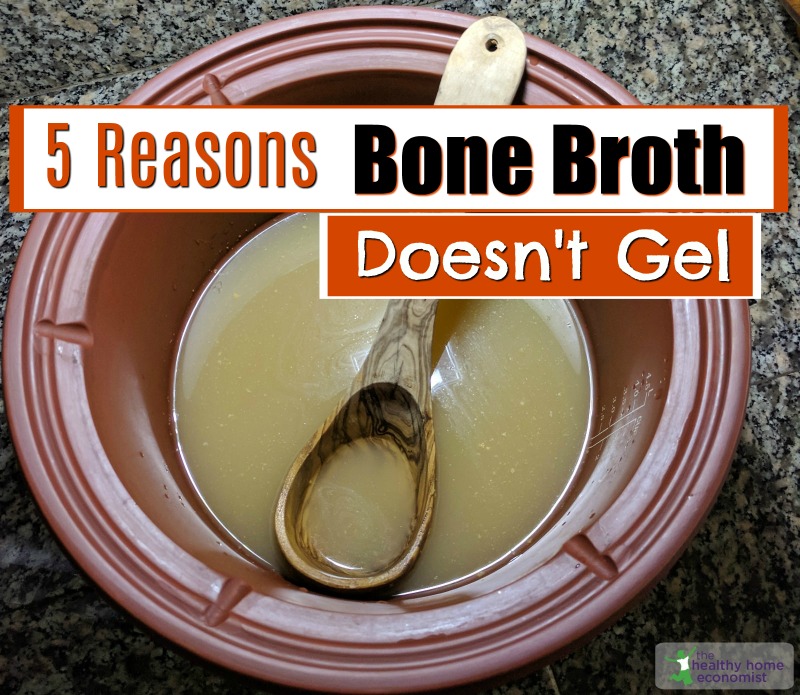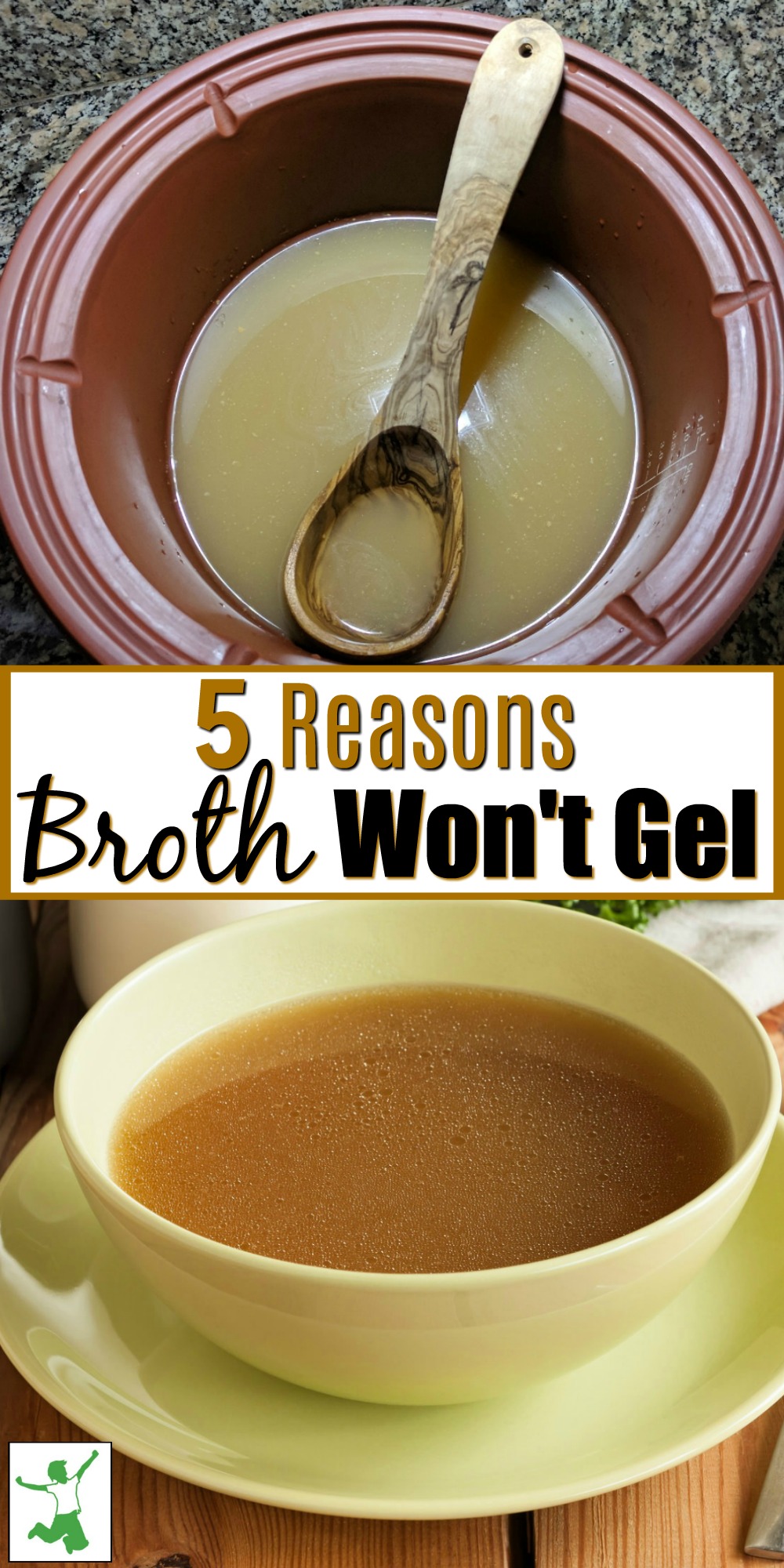
Do you have frequent trouble where your homemade broth doesn’t gel after being chilled in the refrigerator? This is a problem to solve quickly, as correct preparation is one of the foundational techniques of Traditional Cooking.
So critical is properly made, gelled homemade stock to the ongoing maintenance of health that Dr. Francis Pottenger MD, author of the nutrition classic Pottenger’s Cats, considered the stockpot the most important piece of equipment in the kitchen.
Homemade stock is so essential because it contains ample amounts of gelatin, a colloidal substance that attracts digestive juices to itself and prevents gastrointestinal bugs from attaching themselves to the gut wall and wreaking havoc. Natural gelatin both assists digestion and keeps you well!
In addition to gelatin, stock contains minerals such as calcium, silicon, sulphur, magnesium, phosphorus, and trace minerals all in a form that is incredibly easy for the body to absorb.
Do you take expensive supplements for joint pain or arthritis?
Simply adding homemade stock on a frequent basis to your diet will do your cartilage, tendons, and joints a world of good as stock also contains collagen, chondroitin sulfates, and glucosamine.
With homemade stock such a critical food to health, it is important to make it correctly. One sign that you have indeed performed the task well is that your stock gels beautifully once it is chilled in the refrigerator.
If you find that your stock won’t gel most of the time, here are the 5 typical reasons why as described by Monica Corrado, MA, CNC, and author of the blog Simply Being Well. Monica teaches cooking classes and does consultations, so be sure to check her website for this information if you could use some coaching.
Reasons Why Stock and Bone Broth Won’t Gel
- The stock rolled at too high a temperature. If stock or broth is simmered too high, the heat will break down and destroy the collagen. To see what the perfect simmer on your stock should look like, see my short video on the subject by clicking here.
- The stock did not roll long enough. Once you get that perfect simmer or “roll” going, be sure that chicken stock rolls for 6-24 hours and beef stock for 12-50 hours. Less than that will likely not draw enough gelatin into the stock from the bones.
- Not enough of the right kind of bones were used that yield gelatin. To get the right mix of bones that yield gelatin versus other types of bones that add flavor and color, make sure you use one of the following methods: 1 whole, free-range layer hen with neck and wings cut up, 3-4 lbs of boney chicken parts which includes a combo of necks, backs, and wings, OR the picked carcass of 2 meat chickens. For beef stock, use about 7 lbs bones total (4 lbs of boney bones and 3 lbs of meaty bones).
- Too much water was used in proportion to the bones. For chickens, the correct proportion is 3-4 lbs of bones per 4 quarts of filtered water. For beef stock, the correct proportion is 7 lbs of bones per 4 quarts of water or more to cover.
- Using bones from battery chickens or chickens raised in cages. Conventionally raised chickens or chickens raised in cages typically yield little to no gelatin. It is worth the extra money to get quality when you buy meat especially if you will be using those bones to make stock.
To get additional gelatin, add 2-4 chicken feet to the stockpot or even the head for even more! If your chicken is a rooster, add the comb. This will also add gelatin along with testosterone to the stock which adult men may find appealing as levels tend to decline with age.
Failsafe Solution If Your Stock Won’t Gel
If despite all your best efforts, you still come up with a pot of stock that does not gel, add 1 TBL of powdered gelatin per quart of liquid.
Vetted sources of good quality gelatin are available under the Supplements Section of my Shopping Guide.
Hopefully, these tips will help you solve the riddle of why your stock doesn’t gel so that the time you spend on this age-old culinary tradition is well spent producing the most nutrient-dense stock possible!

More Information about Gelatin
The Reason You Need More Gelatin in Your Diet
Gelatin and Collagen Hydrolysate: What’s the Difference?
The Benefits of Gelatin and How to Get More in Your Stock
Video: Stock that Gels!
More Information on Broth and Stock
How to Make Turkey Stock
The Healthiest and Best Bone Broth
How to Make Duck Stock
Rabbit Stock
How to Make Beef and Chicken Stock
How to Make Shrimp Stock
Confused about Stock versus Bone Broth?
The Perfect Simmer on Your Bone Broth








I’ve heard that after 3 hours the fat becomes rancid and must be poured off as a stock then more water is added to make a bone broth, have you discovered this?
I read it at eatbeautiful.com but have not read it anywhere else. Would you please comment? Thank you!!
I’ve been wanting to take in more bone broth, but I’ve recently read scientific studies that say cancer feeds on collagen. In 2016 I went through therapy for breast cancer. Do you have anything to contradict the cancer/collagen connection?
I have not seen any credible research as to why someone with cancer should avoid bone broth…in fact, it improves the immune system considerably so should be beneficial. Now, if someone is undergoing chemotherapy which DEPRESSES the immune system purposely to allow the chemo drugs to work, then perhaps bone broth during that time would be contraindicated. From your comment, it seems you are not doing chemo currently, so check with your doctor that it is fine to introduce this wonderful food.
What are your thoughts on using the Instant Pot for broth making?
I’m not a fan of the Instant Pot for broth because properly made bone broth has some ACV added at the start, which makes the broth an acidic pH…. which risks leaching nickel from the stainless steel. I use a clay pot for broth for this reason (as shown in the photo). https://www.thehealthyhomeeconomist.com/go/vitaclay/
Does a slow roast of the bones prior to making the stock help to release the collagen in the bones?
I made bone broth in the pressure cooker (which I thought was going to be a life saver for me!) but it didn’t gel. I thought that maybe I didn’t cook it long enough and I jumped online to see what the right amount of time would be– but then I found this article. Now I’m wondering if it’s too high of a temp and that is why it didn’t gel. Sarah, can you make bone broth in a pressure cooker?
THANK YOU!!!
I don’t recommend a pressure cooker for bone broth. https://www.thehealthyhomeeconomist.com/pressure-cooker-pros-and-cons/
I use a Vita-Clay, which in my opinion, produces better and safer results. https://www.thehealthyhomeeconomist.com/resources/#19
My first two attempts at bone broth did not gel. I was cooking it too hot. 20 hours on the lowest stove setting was perfect. Apparently my crock pot was too hot too. Thank you for the tips! Success!
Have you ever added deer hooves to your broth? I assume they would have a large gelatin content, but can’t find any information on doing so. I know antlers have been used to make soups, but I see nothing in my books or online about the hooves. Thanks!
So if it has to roll does that mean it won’t gel if it’s made in the crock pot?
That’s what I used last time I made beef bone broth. That being said though I don’t think I used 7 pounds of beef bones though. It was probably more like five pounds to probably less than a gallon of water.
I also put in a couple chicken feet, which I thought would help wit the gel factor.
I do find though that when I boil or even cook in the crock pot an entire chicken, the broth that is made from that is always very gelatinous.
All bones I’m referring to are from local grass fed cows and the chickens are truly free range raised by same farmer I get my beef and bones from.